Once again about tanks, Soviet and German
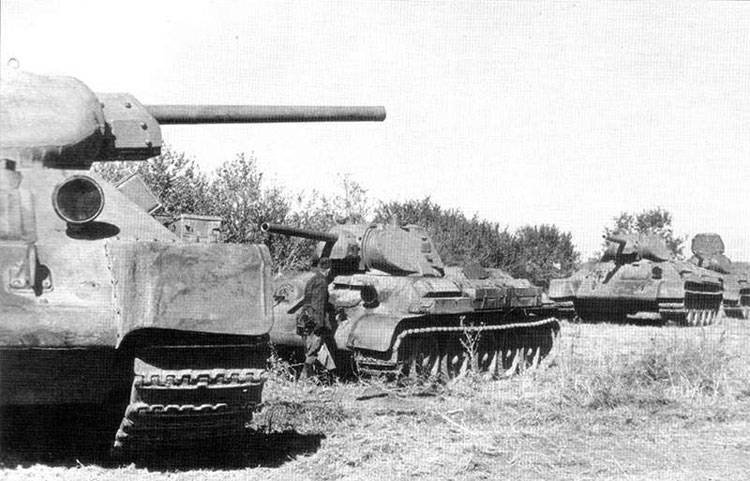
(popular wisdom)
Anything not to know is not shameful.
(D. Diderot)
Necessary preface.
This section, as well as the above epigraphs, is not the author’s desire to get into great literature, but only the need to identify some initial points that may remove (or significantly reduce) the indignation of the dear participants of the forum in case of noticed errors of different levels of depth. This work does not pretend to be true in the last resort, but is only a weak attempt by the author to understand a pile of facts and data that are available in the literature and on the Internet, about the tactical and technical characteristics tanks, which were in service with the Red Army and the Wehrmacht by June 22, 1941, as well as an attempt at a small analysis and generalization of those. As far as I have succeeded, you must judge ...
Where to start?
(ancient greek wisdom)
The question in the title of the chapter is not a tribute to the Russian mentality with its eternal problems. As it seems to the author, one of the stumbling blocks when comparing and evaluating tanks of the USSR and Germany during the period of the beginning of WWII is that at that time there was no single tank concept in the world. And, therefore, a single classification of tanks. And only with time, when tanks became an independent type of armed forces, when the tasks and capabilities of tank formations became clear, the tactics of their use became clear, then the classification of combat vehicles began to crystallize. At the same time, it was different in different countries (in accordance with their vision of armored vehicles). And it turned out to be the first (but far from the last and not the most difficult) problem that had to be faced. Thus, in England and France, tanks were considered a means of reinforcing infantry and were divided into infantry escort and cruising tanks. In the USSR, by the beginning of the Great Patriotic War, there was already a classification system based on the weight of the machine: light (up to 20 t), medium (20 - 40 t) and heavy (over 40 t). The use of such a classification is obviously related to the carrying capacity of bridges and railway platforms.
The German army also had the same classification, but it was based on the power of weapons: tanks with machine guns, tanks with light cannon weapons and tanks with heavy cannon weapons. Light cannon armament included cannon caliber from 20 mm to 50 mm, and heavy cannon armament - cannon caliber from 75 mm and above.
In our comparative analysis, I will use the proven Soviet classification system, and not only for reasons historical proven by time. In my opinion, the weight of the machine characterizes its security, since its main share falls on the armor protection of the hull and turret (sheet thickness). Based on this criterion, we will evaluate and compare combat vehicles of the Red Army and the Wehrmacht on the eve of the Second World War (Table 1):
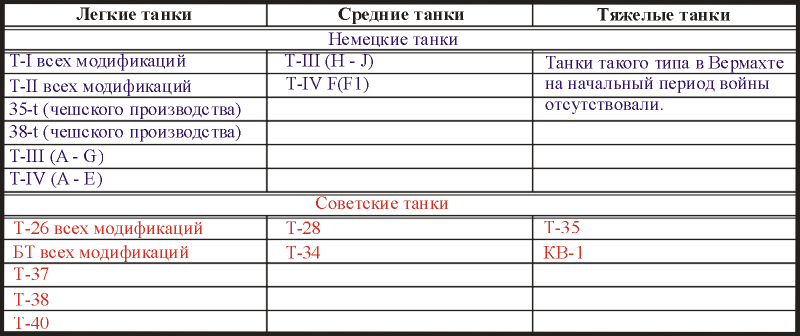
However, this approach, according to the author, is not complete enough: light tanks are quite different in composition and power of weapons. This is due, apparently, to the fact that, historically, the search for solutions to the configuration of the combat vehicle was allotted little, and the military had to approach the formation of tank units on the principle of "what we have" and not "what you will."
On this basis, light tanks are also divided into two subgroups: machine-gun and machine-gun (guns of caliber up to 37 mm inclusive). For medium and heavy tanks such a unit does not make sense: in them machine guns are clearly auxiliary weapon.
Second The comment will concern the use of tanks on the battlefield. Of the variety of tasks to be solved, according to the author, the main ones are two:
a) the destruction of enemy personnel (infantry);
b) the opposition of the enemy's armored vehicles, first of all to tanks.
The solution to the first task is a rather trivial task: since the times of ancient Egypt, humanity has found more and more effective means to destroy its own kind. In the light of the use of tanks, this solution is as follows: a cannon of the highest possible caliber with a powerful high-explosive fragmentation projectile and machine guns, also in the maximum possible quantity. An indicator of the success of the second task will be the value of armor penetration of a tank gun.
In a purely psychological aspect, the task of comparing something or someone in the human consciousness implicitly assumes the presence of an element of competitiveness, confrontation. This confrontation can be resolved either in terms of “who will shout louder (jump, throw, lift, etc.), or in terms of direct clarification one-on-one“ who is in charge at home ”. It seems that in the aspect of the realities of wartime, the second approach would be more correct, i.e. situation of direct collision of tanks of two opposing sides. And, therefore, from all the performance characteristics of tank guns, we choose only the value of armor penetration. All other characteristics, if necessary, will be considered as auxiliary.
Third: Many German (and some Soviet) tanks, despite the different markings, were of the same type, differing in minor technological details, or represented a continuous line of improving combat qualities. In this case, the most successful modification will be selected as the comparison machine.
Fourth The remark concerns the comparison of calibers: in German and Soviet practice there existed a slightly different reference system. The first defines the caliber as the distance between the opposite fields of the rifling (A); the second is the distance between the bottom of the opposite rifling (B). In the USSR, the first system was adopted, in Germany - the second [1]. On this basis, instruments of similar calibers (especially small-caliber) will be considered as belonging to the same group. For guns of large calibers (for example, 76 mm and more), this difference is not significant.

Finally, fifth: All tanks will be compared according to their declared performance characteristics. Other factors, such as the quality of the manufacture of armor and ammunition, crew training, the practice of use in combat conditions, etc. will not be taken into account. Similarly, the armor of all tanks is considered identical in its strength characteristics and the protective property will be considered only in terms of its thickness. Nor will we go into the nuances of determining the qualitative (initial and guaranteed) and quantitative (in the USSR, they were more stringent) characteristics of the armor penetration criteria [2].
Light machine-gun tanks.
To begin with, we will clarify the following thesis: a direct collision of such combat vehicles is not only hypothetical, but also highly unpromising: the vehicles of this class had anti-bullet and anti-fragmentation booking, and its defeat with standard weapons was very problematic.
German machine gun tanks of the beginning of the Second World War are represented by machines. T - I modifications А и В. The Soviet range is much broader: amphibious tanks T-37, T-38, T-40, T-26 early modification (sample 1931) (table 2). From a purely methodological point of view, the T-27 tankettes should be attributed to this same group, however, we will not consider this class of armored vehicles due to the deadlock of this branch of the development of military vehicles. We will also not consider armored cars (although Soviet cannon BA were armed with tank 45-mm guns) because of their auxiliary character.
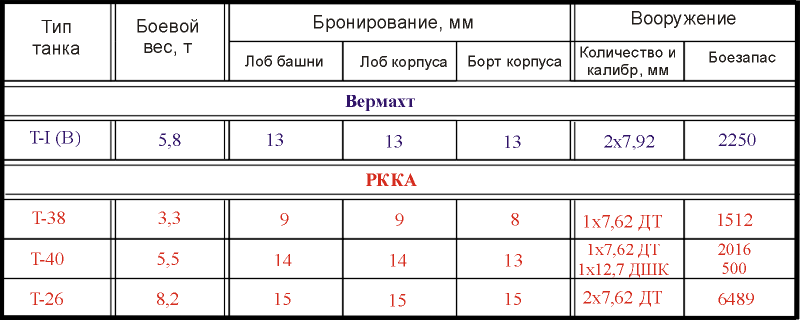
As can be seen from the table, the German T - І exceeded only the Soviet T-38 both in terms of the thickness of the armor and in firepower, which is not surprising: the T-38 is a floating tank. But at the same time, he was hopelessly behind both the newer T-40 amphibious tank (in firepower) and his peer T-26 (in terms of protection). At the same time, the floating T-40 could well have been a deadly adversary for the T-I: its heavy machine gun coped well with thin armor of machine-gun tanks. Superior Soviet tanks of their opponents and ammunition.
It is noteworthy that the Soviet Floating T ‒ 40 surpassed the German LINEAR T - I.
Light machine-gun tanks.
This group is made up of German T - I (C), T - II (AC и F), T - III (A-g)Czech 35 (t) и 38 (t)Soviet T-26 (sample 1932 g) and BT-2 (Sample 1932 g) (Table 3). It seems to be the most difficult in terms of classification. Machines of this class differed not only in design (Soviet tanks were two-tower - a clear echo of the First World War, when the main objective of the tanks was the destruction of infantry in the trenches, and the possibility of simultaneous firing in two different directions was a pretty attractive quality that single-tower tanks lack), but also weapons. It represented a rather variegated palette: from automatic 20 mm guns that had a clear aviation (or anti-aircraft) origin, to small-caliber artillery, developed on a very different basis. Without going into details of the genesis of the development of the armament of these tanks, we confine ourselves to considering their performance characteristics.
If the tanks of the T-I and T-II series are becoming more or less clear, then the "troika" require some clarification. To begin with, the cars of the first four episodes (AD) were most likely experienced specimens, which practically did not have to fight (information on this is contradictory. For one of them, all 95 machines were cut into metal and spare parts, according to others, some of them happened to take part in the Norwegian and Danish operations). The first really massive and battle tank was the modification Е and all subsequent ones. In the original version, they were installed 37-mm guns KwK 36 L / 46, which in 1940-41. were replaced with 50-mm KwK 38 L / 42 (the reserve of modernization allowed it). The same applies to series tanks. E и G. In this part, only machines with 37-mm guns will be considered, since by the beginning of the Second World War the Wehrmacht had T-III with both 37-mm and 50-mm guns, which will be discussed below. Here are their characteristics:
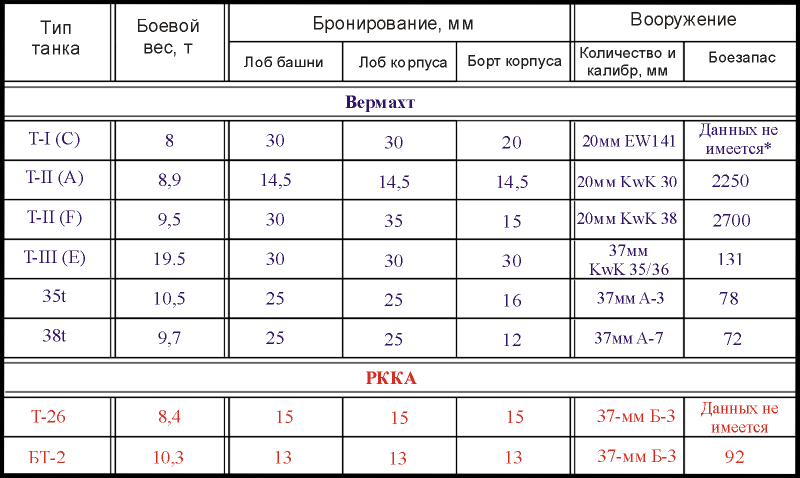
*) - here and below: this entry only says that the data is NOT AVAILABLE BY THE AUTHOR.
It immediately catches the eye that tanks of this category are sharply divided into two weight groups: some have approximately the same combat weight (8 - 10,5 t), while T - III discords with a value in the area of 20 t. Such a sharp increase in weight is not accidental: The first modifications of the tank had a mass of 15,5 T (Ausf a)which gradually increased to 19,8 t (Ausf d). These changes were made in connection with the demand of the military to strengthen the protection of the tank, which was reflected in an increase in the thickness of the armor (and, accordingly, the weight of the tank). At the same time, all other characteristics either remained unchanged (armament) or underwent minor changes (engine power, chassis). The “troika” of the early modifications of the A - D essentially remained experimental machines, and I consider their consideration in this aspect to be meaningless.
As for weapons, then it should also be discussed in more detail, since there is considerable inconsistency in it.
To begin with - German 20-mm guns. EW 141 gun - Aviation automatic weapon, adapted for installation on the tank. True, in the literature you can find the opinion that this is not a gun, but a heavy machine gun. The author failed to find any data on the range of ammunition and their capabilities.
20-mm guns KwK 30 L / 55 и KwK 38 L / 55 they are essentially the same weapon developed on the basis of a small-caliber anti-aircraft gun and differing in their purely technological features. Ammunition and characteristics are the same (hereinafter, the data are given only for armor-piercing projectiles of all types used on these guns) [3, 5, 7]:

More serious opponents were tank guns A-3 and A-7 of captured Czech tanks 35 (t) and 38 (t).
Škoda 37 mm A3 (German version 3,7cm KwK 34 (t)) - anti-tank 37-mm gun manufactured by Škoda, mounted on Lt vz 35 tanks. The barrel length was 39 calibers (1448 mm), the initial speed of an armor-piercing projectile with a mass of 0,85 kg was 675 m / s, which was enough to break through the 40-mm armor plate at a range of 500 m. with [0,825].

Škoda 37 mm A7 (in German sources is listed as 3,7 cm KwK 38 (t)) - anti-tank 37-mm gun, produced by the Czech company Škoda. The barrel length is 42 caliber (1554 mm), which provided the 0,853 kg projectile with an initial speed of 750 m / s.
For him, shells of two types were supposed: Panzergranate 39 (PzGr.39) and Panzergranate 40 (PzGr.40). The armor penetration table for this weapon [6, 7]:

Both guns have quite similar characteristics and use the same ammunition. Good ballistic performance made these tanks mortally dangerous opponents for Soviet tanks of a similar class at all distances with aimed fire.
German 37-mm gun KwK 35 / 36 L / 46,5 Rheinmetall-Borsig had a barrel length in 45 gauges (1717 mm), which gave the following characteristics to the armor-piercing shells:

Soviet tank gun B-3 was developed by P. Sachaentov on the basis of the German anti-tank gun company "Rheinmetal". Both guns had the same ballistics and device, with the exception of the bolt: like all other designs of the Syachentov, it was with 1 / 4 automation. The armor penetration of the B-3 was as follows: [8]

Of all the tanks in this category, only Soviet T-26 and BT-2 on one side can be considered worthy opponents, and trophy Czech 35 (t) and 38 (t) on the other. All the others simply do not stand up to criticism and can only be considered full-fledged fighting vehicles on 1941. They can only be an unrestrained optimist.
Light cannon tanks
The appearance and existence in the armies of a number of countries of the above tanks with such strange hybrid weapons, according to the author, is due solely to the level of technical equipment of the armies of that time. Let's not forget that all of these machines appeared at about the same time: in the beginning - the first half of the 30-s. The low power of the then existing engines, the insufficient hardness of the armor, the large mass-dimensional characteristics of large-caliber guns — all this made it impossible to install powerful guns in tanks.
But, as you know, progress never stands still. If there is demand, supply will inevitably appear. And the military sphere is a source of inexhaustible demand. And the designer gradually developed more and more acceptable models of tank gun armament. So, from the middle of the 30-ies, a classic light tank model appeared: the weight of the 15 - 20 t, anti-bullet and splinter armor, high mobility. The gun was installed as a compromise between mass-dimensional characteristics and the maximum possible power. With the characteristics of a light tank, these were mainly anti-tank guns.
On the Soviet side, such T-26 steel tanks of the 1933 model with subsequent modifications (1937 g. - conical tower and inclined sheets of the tilled box, 1939 g. - booking reinforcement), BT-5 and BT-7.
From a series of tanks T - III deserve consideration modifications Е и F. If the first of them was the result of design development, then the second was a response to the cruel realities of wartime. In particular, it was necessary to increase the reservation. But further modifications of the "triples" (T - III (H) and T - III (J)), on the basis of the principles voiced above, should be referred to as average.
Consideration of a series of tanks in this category will be somewhat unconventional. T - IVwhich almost all researchers attribute to heavy German tanks, although they make a reservation that this is a classification according to the caliber of the gun. But, just as faithful to the above declared commitment to a single classification, the author will assign them to this class. As for the instrument, then it will certainly be discussed further.
Thus, this niche is filled with German tanks of the series. T - IV modifications А, B, C, D и E. The remaining modifications of the Quartet can rightfully be attributed to medium tanks.
A few words about the differences between these modifications. As usual, the first two were actually identical machines, the differences of which were technological in nature. Modification С already had a more or less massive, but its main difference from the version B was in a more powerful engine and booking a gun barrel. Series machines D received more powerful armor and another mask gun. As for the series of tanks Еthey became the brainchild of the Polish campaign and were distinguished by enhanced armor in the form of additional armor plates on the frontal (30 mm) and onboard (20 mm) armor. Since the main modifications with which Germany entered World War II were D и Еwe confine ourselves to their consideration (with a formal increase in the weight of the tank Е to 21 t).
Soviet BT - 5 и BT - 7 were representatives of one row and the "seven" was the result of further modification and improvement of the line of high-speed tanks. At the same time, it continued to improve even after its adoption. Thus, in 1937, the tank received a conical turret and increased ammunition, in 1938, the caterpillar belt was replaced (with a fine one), the suspension was increased, the rubber bandages were eliminated (the tanks were wheel-tracked), and the fuel stock was increased. In addition, a modification of the BT-1939M was released in 7, in which the B-2 diesel was installed. Otherwise, its characteristics remained unchanged. From the BT series, the most massive was the BT tank - 7 and BT - 7М (a total of about 6000 pcs), which we will consider the characteristics of which.
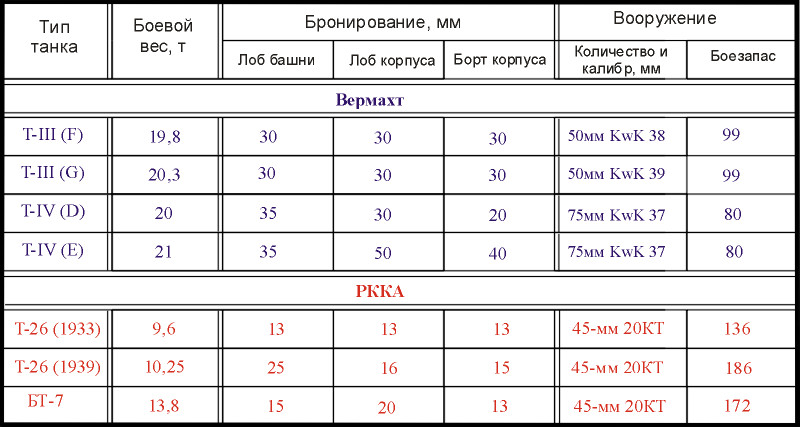
German 50-mm gun KwK 38 L / 42 It was also developed by the designers of the company Rheinmetall-Borsig. It had a barrel length 42 caliber (2100 mm), rate of fire - 15 shots per minute. Used for shooting shots: [3, 7]
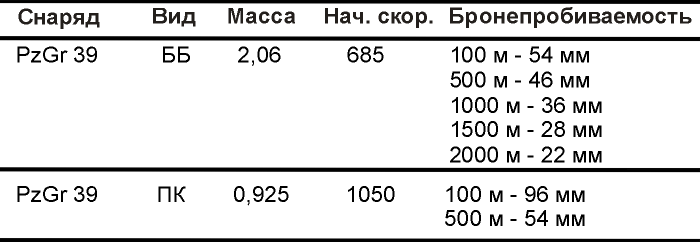
The next modification is 50-mm gun KwK 39 L / 60 - was a modified long-barreled version of the KwK 38 L / 42 gun. The main difference was the greater length of the charging chamber, associated with an increase in the length of the sleeve from 288 mm to 420 mm. The same shots were used for shooting: [3, 7]
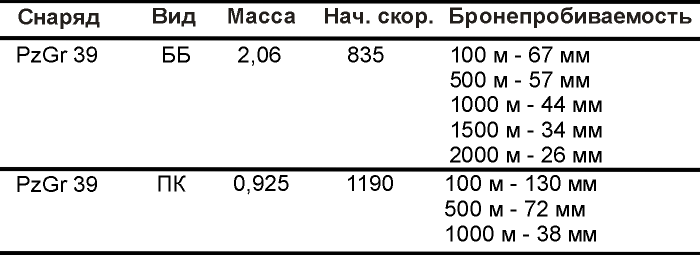
Already at first glance it can be seen that this option was distinguished by much more power and represented, respectively, a greater danger to the tanks.
On all T-IV tanks of early modifications there was one and the same instrument: short-barreled 75-mm gun KwK 37 L / 24 with a barrel length 24 caliber (1765,3 mm). It was designed to combat defensive fortifications (this explains the relatively short barrel), but the presence in its ammunition armor-piercing projectile allowed the tank to successfully fight with armored vehicles protected by anti-bullet or light anti-bullet armor. Her ammunition included shots:

Unfortunately, the data on the characteristics of the projectiles of this gun are not very common, so the author will operate only on his possession, bearing in mind that the armor-piercing effect of the cumulative projectile is much more than the usual armor-piercing and does not depend on the distance.
Soviet 45-mm tank gun 20K was adapted to the fire as armor-piercing, high-explosive fragmentation projectiles. Penetration was as follows [4]:

A brief introduction of the German cannons and the Soviet 20KT's TTX indicates that in a direct collision of Soviet and German tanks of this class, the triples tank guns hit the Soviet T-26 of all modifications from all angles at sighting distances. Soviet tanks were dangerous for the T-III only from a distance of less than 1500 m, which made them virtually defenseless when they met with them in a frontal collision.
Although the Quartet, who were less adapted for anti-tank combat, were also dangerous for Soviet light tanks from a distance of 3000 m, while they could confidently fight their counterparts only from distances not exceeding the same 1500.
To help our tanks overcome this dangerous zone of unrequited fire without significant losses, according to our military theorists, there must have been greater mobility (the specific power of the BT was 30-35 hp / t with an average ground pressure 0,75 kg / cm2 and speed 40 km / h against similar indicators T - IV in 14-15 hp / t, 0,77 kg / cm 2 and 20 km / h). In addition, the chances of success gave a higher rate of fire of the semi-automatic 20KT compared with the KwK 37 and greater ammunition.
As for the tanks of the first two groups, all the cannon tanks were practically invulnerable for them, while remaining dangerous for them at all distances of aimed fire.
Medium tanks
Only three German cars belong to this category of tanks: T - III (H, J) и T - IV (F)having the second marking F1.
The modification of the T-III series machines was mainly in the direction of increasing the thickness of armor. Armament remains the same - 50-mm cannon KwK 38 L / 42. The weight of the tank increased to 21,5 - 21,8 t, which only worsened the kinetic parameters of the tank. The modernization of the T-IV tank was developing in the same direction: reinforcement of the reservation and, as a necessary measure (tank weight reached 22,3 t), the use of wider tracks. Armament also has not changed: 75-mm gun KwK 37 L / 24.
Soviet medium tanks were represented by three-turrets. T - 28 and legendary T - 34. Having become the hallmark of Victory, the T - 34 was put into service at the end of 1939 and met the war almost unchanged (only technological changes were made to improve maintainability and improve manufacturability in production). The most significant changes include the installation of a more powerful 85-mm cannon in the new turret and an increase in the number of people in the crew from four to five. As for the T-28, it was an ambiguous design. Built in 1932 as an infantry support tank (sad remnant of the “Tukhachevsky era”), it turned out to be a very good vehicle for its time and for solving its tasks, which remained in the army and went through several minor reconstructions (replacing the KT-28 cannon with L-10, installation of a stern machine gun in the turret, replacement of a cylindrical turret with a conical turret, installation of screens), which did not significantly change its combat properties.
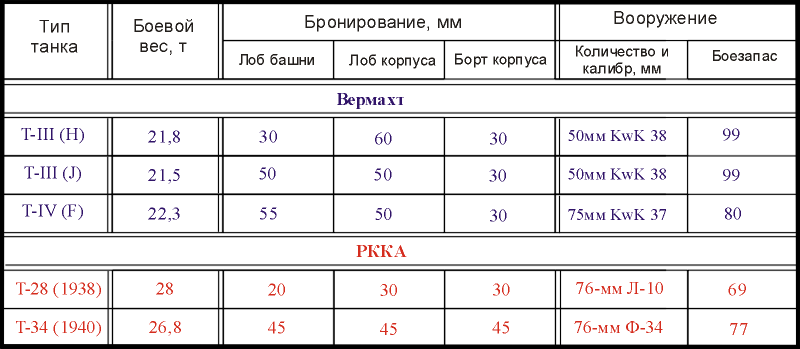
Since the armament of the German tanks was discussed above, let us examine only the characteristics of the Soviet tank guns.
76-mm gun L-10. All that was found: an armor-piercing projectile with an initial speed of 555 m / s at a distance of 500 m punched armor with a thickness of 61 mm, on 1000 m - 51 mm (at an angle of meeting 60 degrees).
76 mm F-34 gun - tank gun of Gorky Plant No. 92, which, starting from 1941, was equipped with T-34 tanks serially. The design of the gun began in 1939, the gun was an elongated version of the F-32 tank gun and was originally designed to arm T-28 and T-35 tanks. The design of the gun was completed on 15 March 1939 of the year, the first tests of the gun mounted on the T-28 tank passed on October 19 1939 on the Gorokhovetsky testing ground. However, the rearmament of the T-28 and T-35 tanks was decided to be abandoned, and the gun was reassigned to the new T-34 tank, in which the first firing of the F-34 gun was made in November of the 1940 year. In addition, the tests were carried out on the tank BT - 7A.
The armor penetration of F-34 shells was as follows (guaranteed penetration):
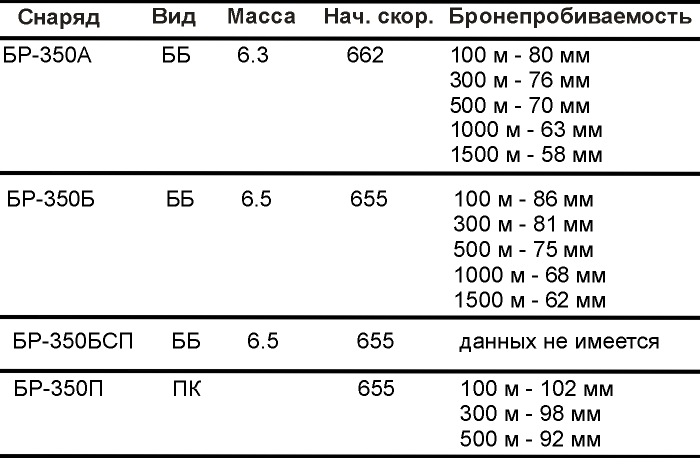
The range of armor-piercing projectiles was 4000 m, high-explosive fragmentation - from 9000 to 13000 m, fragmentation (shrapnel) - 6000 - 8000 m depending on the type of ammunition used. The calculation carried out according to the following method allows us to estimate the armor penetration rate at a distance of 2000 in 51 mm at the meeting angle of 90 degrees and 36 mm - at 60 degrees. Practical rate of fire was 3 - 5 shots per minute.
Heavy tanks
In this category of combat vehicles, no comparison is foreseen due to the complete absence of those in the German army. Soviet cars are represented by the most propaganda tank. T - 35 and the most powerful tank on the 1941 year KV - 1.
Immediately make a reservation: the tank KV - 2 in this context will not be considered. His 152-mm howitzer was designed entirely for other purposes, namely, to break the front edge of a heavily reinforced enemy defensive line, destroy powerful pillboxes and storm URs. By the nature of the tasks to be solved, this machine could be safely attributed to ACS, but a number of features: the presence of a rotating turret, powerful booking, the ability to solve independent tasks — quite distinctly distinguish it from self-propelled artillery. In my purely subjective opinion, the KV - 2 should be attributed to a non-existent type of armored personnel carrier, namely, to assault tanks, i.e. vehicles that are able to solve both tank and artillery tasks.

Tank T - 35 It was developed in the 1932 year as a heavy breakthrough tank and fully corresponded to the realities of the combined arms battle of the time, namely: the presence of large masses of infantry and cavalry; defense in depth, filled with a large number of wire obstacles; the almost complete absence of anti-tank artillery. Therefore, the main purpose of such a tank was to fight precisely with these dangers. The infantry and cavalry were supposed to be destroyed with massive machine gun fire (6 units, 7,62-mm DT machine guns installed in three of its five towers completely blocked all possible attack directions), artillery and closed firing points were suppressed by 76-mm guns CT-28 (later - A-10), and in order to defeat the tanks that were then in the armies of the likely enemy, two 45-mm 20K guns were installed, also providing fire in all sectors. The characteristics of all these guns have been discussed previously.
In the 1939, all the T - 35 tanks available in the Red Army were upgraded: they increased the armor of the frontal part of the hull to 70 mm, the sides and the turret - to 25 mm, replaced the gun. Armor protection of the stern and roof remained unchanged: 20 and 14 mm, respectively.
Heavy tank KV - 1 1940 was developed in the winter of the year and was a generalized experience in the design and production of heavy tanks in the USSR, which also took into account the new tasks facing the troops. Among the requirements for this car were the following: powerful anti-missile booking, able to withstand the new anti-tank guns; a universal weapon capable of not only destroying enemy firing points and its fortification, but also confidently striking all types of enemy tanks that existed at that time.
As such a gun was used gun F-32 V.G. Grabin. In modern literature, the view is often expressed that the KV - 1 tank is insufficiently armed, and at the same time they claim that the 76-mm F-22 is the best that we then had for tanks. This statement, as the author sees it, is rather crafty. An 85-caliber tank gun based on the 52K anti-aircraft gun was in development and could well have been created by that time, while the spacious Voroshilov Tower made it possible to install it without any problems with the presence of space. The problem was different: ironically, but for such a powerful weapon in the tank then there were no tasks. The armor of all enemy tanks was so thin that the BB shells pierced through both sides and flew through without destroying it. In addition, there is also an economic component: the larger the caliber, the more expensive each shot in the country. Therefore, the F-32 caliber 76 mm was found to be quite appropriate for its purpose. It remains only incomprehensible why the F-34 gun, which appeared a little later, was not installed on it. Probably, our old Russian approach is “so good, and the best is the enemy of the good.” Who knows….
In any case, not wanting to spend time discussing the “why and how” questions, the author will limit himself to considering what happened.
The semi-automatic 76-mm tank gun L-11 designed by the Leningrad Kirov Plant with mechanical-type semi-automatics had a barrel of 30,5 caliber length (2324 mm), which allowed making 6 - 7 shots / min. The initial speed of the RP of the projectile was 635 m / s, BB - 612 m / s with the following armor penetration values:

* - calculated according to the following method
In its characteristics, it largely coincided with the f-32 gun of its competitor Grabin, somewhat inferior to it in reliability. And although the history of adopting these guns is replete with interesting and sometimes very intriguing moments, we note only that moment that the availability of well-functioning production caused a compromise: take the L-11 guns into service for the tanks of the Kirov plant, which, obviously, was quite logical .
76 mm F-32 gun - semi-automatic with copy-type semiautomatic, which allowed 5 to be done - 6 shots / min. The barrel length 31,5 (2400 mm) informed the RP projectile initial speed 638 m / s, BB - 613 m / s, which provided the following values of armor penetration:

* - calculated according to the following method
V.G. Grabin mentions that the F-32 was, at the request of the customer and against the will of the designers, noticeably shortened with a perceptible loss of combat qualities for the sake of the then prevailing fear that the tank could hit the ground with a gun. This did not allow F-32 to realize all the capabilities originally incorporated into its design.
So, all the tanks of the Red Army and Wehrmacht that existed on 22 on June 1941 were systematized (to what degree of adequacy, judged by dear readers), now it's time to decide what to do with it. Consider how the available performance characteristics allowed us to solve the problems noted above.
Machine-gun tanks were well suited for the purpose of destroying enemy personnel in open battle, but were ill suited to attack defensive lines. Even a simple trench significantly increased the survivability of the infantry, while the tank itself remained open to defeat by all available means of fighting it. The cannon armament of machine-gun cannon tanks was also not very suitable for these purposes: the power of the high-explosive fragmentation projectile caliber 37- or 45 mm is clearly insufficient for creating a "cloud of fragments" and for defeating enemy DOTs.
The guns of medium and heavy tanks were much better suited for solving the first of the noted tasks, especially the 75 / 76 mm caliber, which is quite understandable - the tools of such a caliber were created just in time for this.
But the question of what will be the result of the collision of these machines in a collision with each other, requires more detailed consideration.
A bit of math
Being a chemist by education, i.e. “Creeping empiricist”, the author could not help trying to find some mathematical generalization of the data on the armor penetration of German and Soviet tank guns. Since the armor penetration curves have a form close to exponential, they were approximated by a type curve

where Br is armor penetration, b (0) and b (1) are coefficients, the meaning of which can be determined as follows: b (0) is the maximum possible thickness of the pierced armor, b (1) is an indicator of the velocity of a projectile’s fall (figuratively speaking hands "of the tank gun) and flatness of the trajectory (having slightly sinned against the rigor and scientific terminology, we call this value a" ballistic characteristic ").
The data of calculations and performance characteristics of the tools are presented in the table:
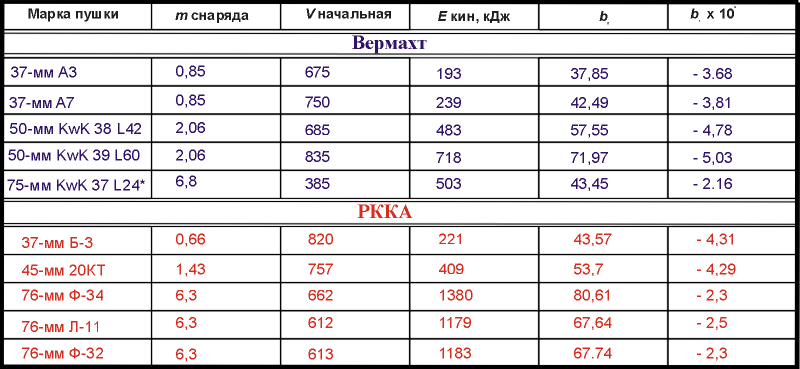
* - values calculated by two points
According to the calculation data, you can immediately see a fairly obvious correlation: the value of b (0) is directly proportional to the magnitude of the kinetic energy of the projectile (muzzle energy). As for the value of b (1), its expression is not so obviously related to the parameters of the gun and the projectile.
This mathematical model allows you to calculate a table of target destruction at different distances and build armor penetration curves. For German guns, they look like this:
Defeat table
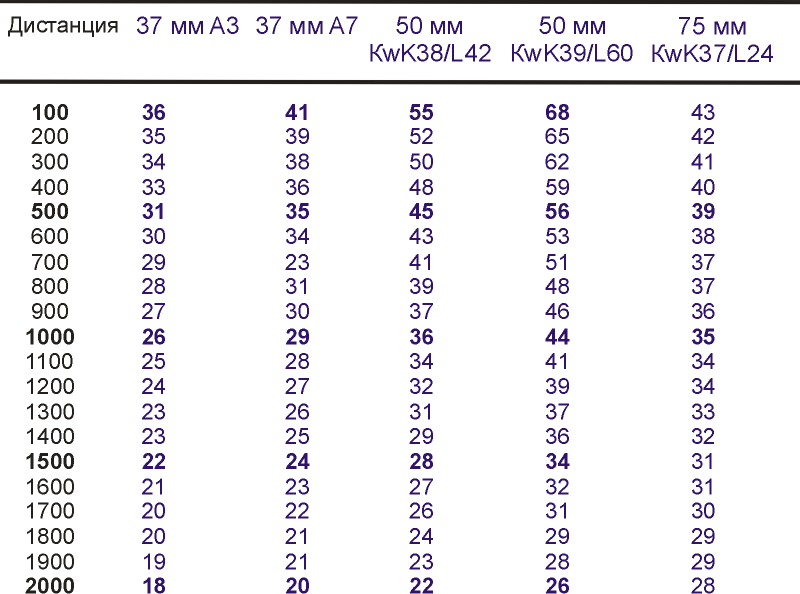
Armor penetration curves
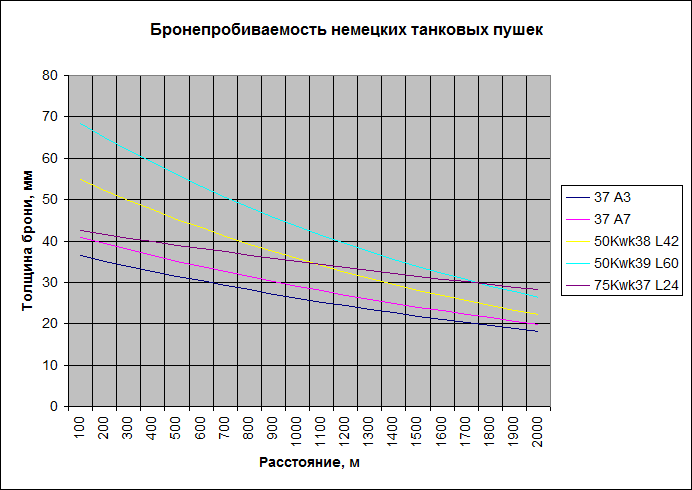
for the Soviet - so:
Defeat table
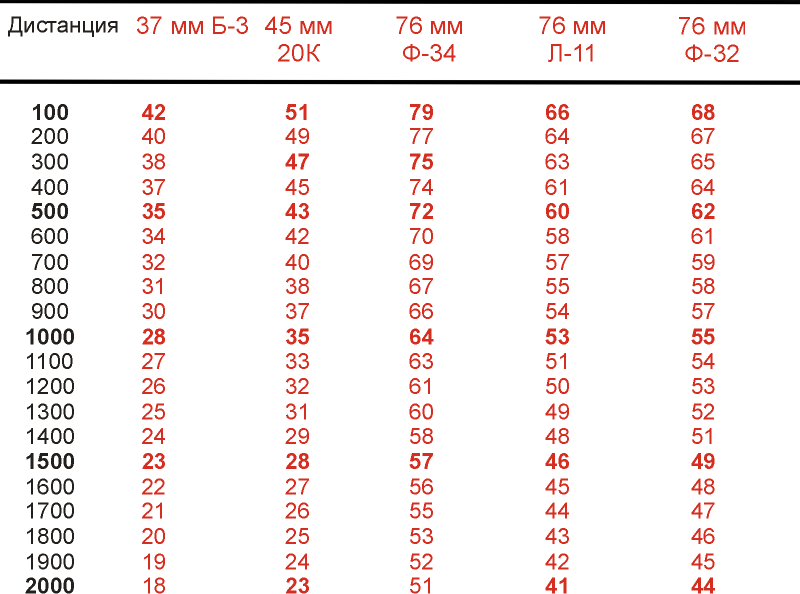
Armor penetration curves
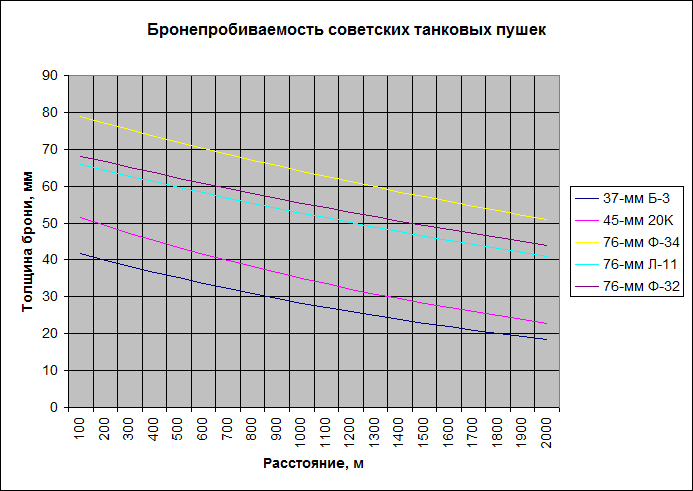
Calculated values are highlighted in bold, which are well (I would say excellent) consistent with the table data.
Based on the exponential dependence of armor penetration on the distance, it is possible to calculate the limiting armor penetration distance using the formula

where Tbr is the thickness of the armor, X is the distance at which it makes its way.
Below are the tables of calculated distances for the considered tanks, based on the assumption that they occur forehead-by-forehead:
The shaded cells show negative values, which by themselves have no physical meaning, but are a good illustration of the “uselessness” of these guns against these tanks, so to say, the magnitude of the value indicates the degree of this “uselessness”. In practical terms, this may be some characteristic of the possibility of upgrading an instrument, i.e. the answer to the question: could ETA gun, in principle, penetrate the armor of this tank.
Even a simple comparison of the data shows that the characteristics of the B-3 gun practically do not differ from those of the Czech-made A3 and A7 guns, approaching the latter more. The 20K gun, having an average caliber between the German A7 and 50 Kwk, is inferior to them in the muzzle energy, but surpasses in the flatness. 50-mm KwK 39 L / 60 looks especially great in this class, surpassing all predecessors up to 1700-1800 m distances. For the initial BOB period, such a “long arm” was just a great indicator and this system obviously shows the maximum possible characteristics for guns such calibers.
Discussion of the advantages and disadvantages of 75-mm guns KwK 37 L / 24 installed on all tanks of the Pz IV modification, unnecessarily - a short barrel with a large caliber could tell a sufficient amount of kinetic energy, but with a pulse value of 385 (kg m / s) she could not provide greater flatness of the trajectory. In other words, it was a vehicle against infantry, which could more or less effectively fight tanks at close distances (for large ones it was difficult to carry out mounted aimed fire at a maneuvering target).
As for the Soviet "heavyweights", then everything is just plain and clear: the guns had enormous potential, which allowed them to more than effectively solve both anti-tank and anti-personnel tasks. Despite the fact that the barrels of these guns were trimmed compared to their field counterparts, with a high initial velocity of the projectile, they maintained high (and for some purposes and excessive) armor penetration, as well as effectively solving anti-personnel tasks (destruction of manpower, destruction of pillboxes , battery fire suppression), which were solved by a wide range of projectiles (this information is not given in this article, but is widely represented on the Internet).
Now about the possible development of the situation when meeting the opponents in various combinations.
To do this, we first group the tanks into groups according to the thickness of the armor (1 criterion), ordering them within the groups according to the tools installed on them (2 criterion). In the Wehrmacht it will look like this:

A similar table for Soviet tanks gives the following distribution:

What could wait for them when they met on the battlefield "forehead-to-forehead"?
20-mm guns of light German tanks represented a relative danger only for light tanks T - 26 model 1931 g. And BT-2, and then only from a distance of no more than 500 m, while they confidently hit T - II (A) starting with 2500 m. More serious opponents were stronger T-I (C) reservations, whose armor made their way only from 850 m and even more thick-skinned T-II (F), which were taken only from 500 m. For the rest of the Soviet tanks they did not pose any danger.
It makes no sense to look at single combat with other Soviet tanks: only relatively poorly booked T-28s could be hit by “Czechs” from a distance of no more than 900 m, while they themselves could be guaranteed to be destroyed by them from a distance of 4 km. The same applies to the T - I (C), whose 30-mm armor was penetrated by the Soviet L-10 with km 3,5.
With this phrase, we smoothly moved from the first group of German tanks to the second. More powerful weapons made them deadly opponents for our T-26 and BT of all modifications, shooting from distances from 2,5-x to 3,5 km, while those could bring them damage only from a distance of 1000-1300 m, which was clearly not enough with a tank duel. The only salvation was the successful concentration of fire and maneuver, as well as the use of support forces (artillery, infantry, aircraft). And only the old T - 28 still quite confidently could keep opponents at a distance of 3 km or more.
A hypothetical meeting of tanks of the second group could well look the most dramatic. Not the most convincing for this 50 KwK 38 artillery system was reinforced with more solid armor, and the 75 KwK 37 already had enough penetration, as the Germans believed.
Soviet counterparts could oppose not only quite solid armor protection, but also powerful 76-mm guns. At the meeting of these cars, the Germans had an advantage only over T - 28, which they acquired at a rather high price - thick armor led to the almost complete exhaustion of the reserve for upgrading the "triples". As for the "fours", the approximate parity with the T - 28 could put the German designers before a difficult dilemma: to increase the thickness of the armor or to increase the power of the gun. Do not be on the battlefield of the legendary "thirty-four", then perhaps they would have gone the standard way: to increase the thickness of the armor plate is always easier than developing a new artillery system. But the almost complete impossibility of penetrating the T-34 frontal armor with tank guns solved the task unequivocally - to create a weapon that can hit Soviet tanks from a distance of more than 2000 m to keep them at a safe distance. The very same T - 34 could deal with any of his opponents from any distance, while remaining invulnerable from any distance of aimed fire.
Talking about HF - 1 fights with the Germans is not necessary: they could only be dealt with in the Wehrmacht with the help of 88-mm anti-aircraft guns and corps artillery.
With such an abundance of used tank guns both in the Wehrmacht and the Red Army, the question naturally arises: what kind of gun was better? As you know, the most difficult answers have to look for the most simple questions. This is no exception. I will try to answer it from my bell tower.
Distracting from the specific requirements that the military set before the designers, the author will allow himself to define as criteria high muzzle energy (b0) and the ability to retain striking abilities (b1) for a long time. According to the first parameter from 37-milemetrakov, the Soviet B-3 seems to be the most acceptable, according to the second - the Czech A3. From the combination of both, almost none of them has an overwhelming superiority and the choice in favor of any lies entirely in other planes.
The second group of guns demonstrates the clear superiority of the German gunsmiths, especially the 50 Kwk39 / L60 cannon, surpassing the only Soviet 20K in magnitude of muzzle energy. The high ballistic characteristics of these guns made it possible to put up with their rather rapid fall (which is understandable: no one has yet canceled air resistance).
But in the third group of guns, the Soviet guns had no analogue: high muzzle energy, pulse values of about 4000 kg m / s in combination with a large mass of projectile made it possible to maintain high armor penetration at long distances.
Summary
So, whose tanks were better? The answer is obvious. The mere abundance of modifications of the Wehrmacht’s combat vehicles indicates that unfinished models were put on stream, the shortcomings of which were eliminated during combat operation. Pure machine-gun tanks and tanks with small-caliber guns of aviation origin at the beginning of the forties is not even technical stupidity. Such a machine could be dangerous only for tanks of the “era of Tukhachevsky”, but not for the works of Koshkin and Kotin. Even the somewhat archaic looking T - 28 was obviously too tough for them, what to speak of more powerful or more modern machines. Even Soviet armored cars armed with the same 20K guns were dangerous for these “Wehrmacht armored monsters” at distances where they didn’t really get “miserable guns” *. Increasing the booking is the easiest way to increase the survivability of the tank in battle, but it is also the most unpromising. Weight gain, reduced mobility, the need to increase engine power - all these tricks quickly eat up the resource of modernization and, sooner or later, put designers to the need to develop a new car. The failure of Polish tank forces and the headlessness and carelessness in using tank forces in France played a cruel joke with the Germans: they never met a really serious opponent. The episodic use of the English Matilds in France did not make the conclusions either: the monstrosity of the tank, combined with their meager numbers, made it possible to solve this problem by other non-tank means. German anti-tank artillery was not in the best condition either. Having generally more powerful systems, they remained at the level of the tasks of the beginning, at best - the mid-thirties.
Soviet tanks did not suffer from pettiness, although they, too, were not without flaws. These are low reliability of engines, low quality of optics, lack of sufficient radio stations, low level of comfort, and crew overload with work — this is not a complete list of the problems of our combat vehicles. Add here and the low professionalism of specialists (mechanics were taken from collective farm tractor operators, commanders were generally taught at accelerated courses), and a large percentage of defects in the production of ammunition (it is here that one must look for the cause of the low REAL efficiency of the "forty", and not in their inherent depravity), and many other things, but the combat vehicles themselves were quite modern and fully meeting the challenges of not only modernity, but also some future. Tanks of earlier releases were more or less specialized, T - 34 and KV - 1 were universal tanks. Machines of this class were not in any other country in the world. As for the Wehrmacht, only the luck of the first year of the war gave the German designers a head start to develop effective objections to Soviet realities. Only in the summer of 1942, Pancervafe received a car that remotely matched the X-34 development of 1940, and only in the summer of 1943, the Panthers, slightly superior to their prototype, and the Tigers, which are significantly superior to the X-1, developed the same already forgotten 1940 th. And this is despite the fact that the Soviet response to this zoo was followed in half a year and a year, respectively. Comments, as they say, are superfluous ...
____________________
*) This quote is taken from some publications of Russian “historians” who clearly tried to hide the truth ...
Conclusion
The number of copies broken in discussions on this issue, certainly exceeds the number of them broken in real battles of human history. By adding another twig to this pile, the author did not set an objective to simply clutter up the space. As Moliere said, “all genres have the right to exist, except for boring,” and if so, then this point of view on this problem, as the author seems, also has a right to exist. By presenting this review to the public, the author hopes for constructive criticism. Also, the author will be grateful if dear opponents point out errors in calculations and facts. These comments can be voiced both on the forum and in personal communication.
Literature
In this section, I also want to make a reservation. Information gathering took more than one year and did not have the character of a target. Simply the author himself wanted to understand the existing situation. That is why a large amount of data was already stored in the form of numerical characteristics, not marked with links. Therefore, the author apologizes for the incomplete list of sources of information below:
[1] http://www.armoury-online.ru/articles/ammo/pistol-ammo/calibres/
[2] http://vif2ne.ru/forum/0/arhprint/936479
[3] http://www.battlefield.ru/armor-penetration-german-guns.html
[4] http://opoccuu.com/20k.htm
[5] http://dzromon.narod.ru/gun/push/20mm.htm
[6] Wikipedia, article "Skoda 37 mm A7"
[7] http://vn-parabellum.narod.ru/ger/ger-t-gun-pen.htm
[8] Wikipedia, article "37-mm tank gun model 1930 of the year (5-K)"
And also:
M. Svirin. Artillery armament of Soviet tanks 1940-1945. Armada-Vertical, #4
M. Baryatinsky. Light tanks of the Second World War. - M .: Collection, Yauza, EKSMO, 2007.
M. Baryatinsky. Tanks of the Second World. - M .: Collection, Yauza, EKSMO, 2009.
Tanks of the world. / Compiled by R. Ismagilov. - Smolensk, Rusich. 2002.
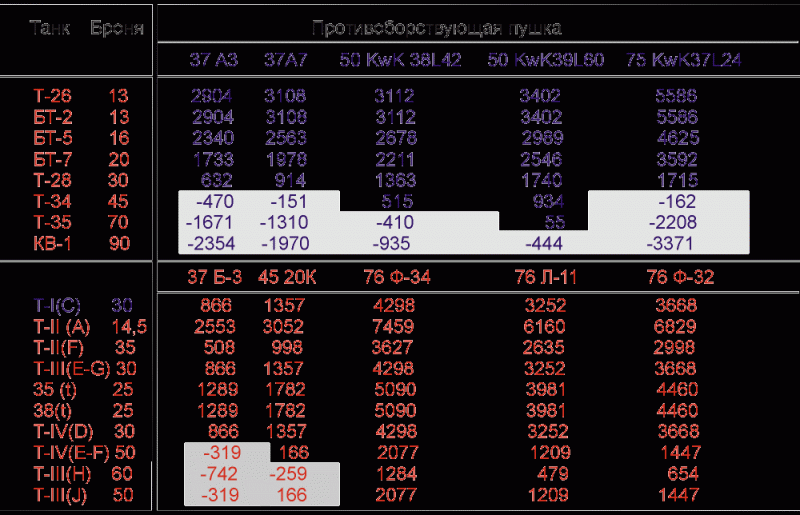
Information